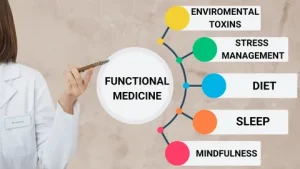
The Root Cause Revolution: How Functional Medicine Rewrites the Story of Autoimmune Disease
For decades, millions of people have lived under the weight of autoimmune diseases—conditions where the body turns against itself.

Few challenges in neurological rehabilitation are as complex and urgent as the recovery process following a traumatic brain injury. While mainstream medicine has traditionally leaned on pharmaceutical interventions and surgical procedures to address such injuries, a growing body of research and clinical success suggests that the brain may be more flexible and self-healing than once thought. At the forefront of this shift stands the work of Dr. John W. Jung “Alternative Treatments to TBI”, a chiropractic physician whose approach emphasizes the power of sensory therapy as a catalyst for cognitive and neurological renewal.
Sensory therapy represents an alternative approach grounded in the principle of neuroplasticity, the brain’s remarkable ability to reorganize itself by forming new neural connections throughout life. This adaptability becomes especially crucial following traumatic events that disrupt the normal pathways of brain function. Sensory therapies operate by tapping into the body’s intrinsic sensory systems, vision, sound, smell, touch, and motion, to re-stimulate brain regions affected by trauma. Rather than suppressing symptoms, these therapies seek to awaken dormant neural circuits, enabling individuals to recover lost functions through repeated, gentle stimulation.
Dr. Jung’s methodology is rooted in clinical experience and a sophisticated brain structure and function. One of the critical insights he presents is the dynamic interaction between the frontal lobe and the cerebellum. These two brain regions, responsible for decision-making and motor coordination, are deeply interconnected. As Dr. Jung explains in his book, the frontal lobe processes information from the opposite cerebellum approximately 95 percent of the time. This fundamental relationship forms the basis for many sensory interventions he proposes. The opposite cerebellar region is engaged by targeting one hemisphere of the brain through sensory inputs, creating a powerful feedback loop for healing.
Among the many applications of sensory therapy outlined in Dr. Jung’s work are those involving visual engagement, auditory stimuli, olfactory exposure, and movement. Each has a unique capacity to rewire the brain in specific and measurable ways. Patients may be guided to read simple word lists while tracing patterns with their eyes or hands, stimulating both linguistic and spatial processing areas. Music, too, plays a critical role. Depending on which hemisphere requires stimulation, auditory inputs can be directed through the right or left ear to optimize cerebral response. Similarly, using pleasant or unpleasant scents through a targeted nostril can activate corresponding areas of the temporal lobes.
The results of these seemingly simple interventions can be profound. In clinical settings, patients have reported significant gains in focus, balance, and memory recall within a matter of weeks. One particularly striking case involved a middle-aged patient suffering from persistent brain fog following a mild concussion. After integrating a combination of olfactory stimulation and visual maze-tracing exercises into his daily routine, the patient experienced a noticeable improvement in clarity and responsiveness. These outcomes are not anecdotal anomalies; they are grounded in repeatable therapeutic principles backed by neuroscience.
Sensory therapy’s noninvasive, holistic nature sets it apart from traditional treatments. No pills, incisions, or risks are associated with medication side effects or surgical complications. Instead, the therapy empowers patients and caregivers with tools to implement in their homes. This democratization of healing, placing effective techniques in the hands of ordinary people, represents a revolution in the care and recovery of brain injury survivors.
Moreover, sensory therapy aligns with an increasingly accepted understanding that the brain is not a fixed, unchangeable organ, but a living, evolving system. Every thought, sensation, and movement has the potential to forge new pathways or strengthen existing ones. The therapies discussed by Dr. Jung harness this potential, offering hope to those who may have been told that recovery is unlikely or that only limited gains are possible.
His commitment to holistic healing for brain injury is both visionary and practical. By focusing on the inherent connections between mind and body and advocating for interventions that respect the body’s natural rhythms and capacities, he offers a blueprint for recovery that is as empowering as it is effective. Sensory therapy is not a panacea, nor does it replace the need for medical oversight in severe cases. However, for many patients, it represents the missing piece in a puzzle that modern medicine has yet to solve entirely.
In a world where trauma often leads to prolonged disability and diminished quality of life, the insights offered in Dr. Jung’s work signal a new beginning. They remind us that healing does not always require high-tech solutions or pharmaceutical intervention. Sometimes, the path forward lies in the senses in the sights, sounds, smells, and movements that reconnect us to ourselves and the world around us.

For decades, millions of people have lived under the weight of autoimmune diseases—conditions where the body turns against itself.

The human brain is one of the most extraordinary organs in existence—capable of adapting, learning, and healing itself in ways that science is only beginning to understand.
Sign up for Dr. John W. Jung’s newsletter and receive exclusive content on brain injury recovery, alternative treatments, and cutting-edge research. By subscribing, you’ll get expert tips on improving brain health, updates on new therapies and research findings, special offers, upcoming events, and exclusive excerpts and bonus content from Dr. Jung’s work.
Don’t miss out—join our community today!